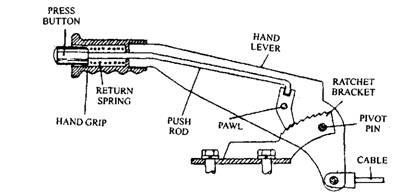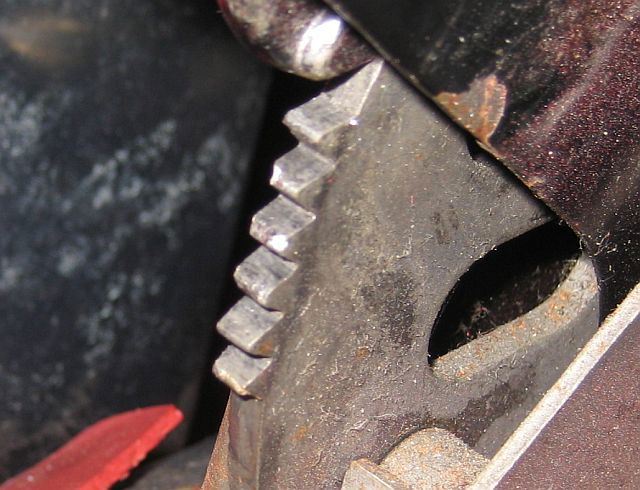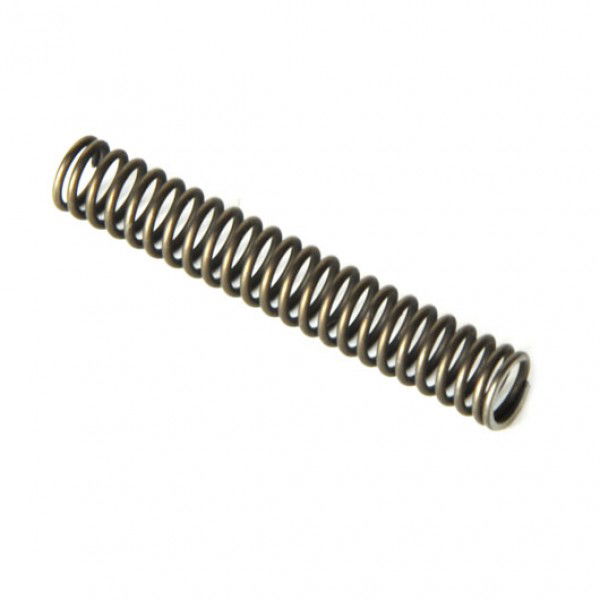Should you press the button when pulling the handbrake or not?
The argument of the button-pressers is that you will wear the teeth of the ratchet down by not pressing the button. Sounds possible, which is why so many people believe it. Which is a pity because it’s wrong. You should not press the button when pulling the handbrake.
The argument of the button-pressers is that you will wear the teeth of the ratchet down by not pressing the button. Sounds possible, which is why so many people believe it. Which is a pity because it’s wrong. You should not press the button when pulling the handbrake.
To understand this we’ll take a look at how the thing works.

The handbrake pivots around a pin and pulls on a cable which is connected to the brake calipers. To lock the handbrake in place when pulled up there’s a ratchet mechanism consisting of a bracket with teeth and a pawl. This pawl is connected via a push rod to the release button. Behind the release button there’s a spring. To make the pawl lock between the teeth of the ratchet bracket it has to be pushed against this bracket. This is done by the spring behind the button. This spring forces the button outwars, pulling on the rod which in turn makes the pawl pivot around a pin, forcing it between the teeth of the ratchet bracket.

In the picture above you see the ratchet bracket. It’s a picture I found on Google of a handbrake mechanism from an old Merc. As you can see the teeth are a little worn. But this shouldn’t be a problem, because the pawl locks between the teeth and not on the top of the teeth. As long as the majority of the tooth is still there the mechanism will lock, provided there’s enough force forcing the pawl into the teeth. And this is where the problem lies.

The return spring behind the release button is the real culprit. When handbrakes don’t lock anymore people immediately think of the ratchet. But in most cases it’s this spring that’s causing the problems.
When a changing force acts on metal you get fatigue. The metal litteraly gets tired and will deform pretty easily. A spring is based on metal’s resistance to deforming. But when the metal is fatigued there’s less resistance to deforming and the spring will lose some, of it’s compression. If this happens less force is forcing the pawl between the teeth of the ratchet bracket and the mechanism will start failing to lock. It will start to happen occasionaly but after a few months it will happen most of the time.
So now back to our original argument. What’s best, pushing or not pushing the button when you pull the handbrake? If we don’t want our mechanism to wear out we want to put as little force on the spring as possible, because big changes in force is what makes the spring wear out. From this we can conclude that you SHOULDN’T push the button when pulling the handbrake. You should let the ratchet mechanism do it’s work and use the button only when necessary (= to release the handbrake).
Think of it. If you push the button everytime you pull the handbrake you will cut the life of the return spring in half. It’ll take half as much time to wear the spring out than it would normally.
This content was originally posted by a Car Throttle user on our Community platform and was not commissioned or created by the CT editorial team.
Comments
Just leaving this here…
The answer to the most important question in the universe. All for that little spring!
Very good article. I think you cut to the chase quite nicely. keep it up!
I would have thought that the force from it rapidly going in and out 10 times in a second would be more wearing that one smooth larger press over the same time. But it does sound awful xD so i’m gonna keep pressing that button.
Let’s ask Clarkson
Finally been thanked for my bad habit… Now I’m right…
The button is there for a reason…
Wrong! When the ratchet is doing its work (ie pawl is moving up and down on it when pulling handbrake) it moves return spring as well. putting it through more stress and more cycles.
Also the noise is annoying
Jup
So what’s more expensive - replacing the spring or replacing the ratchet?
Pagination